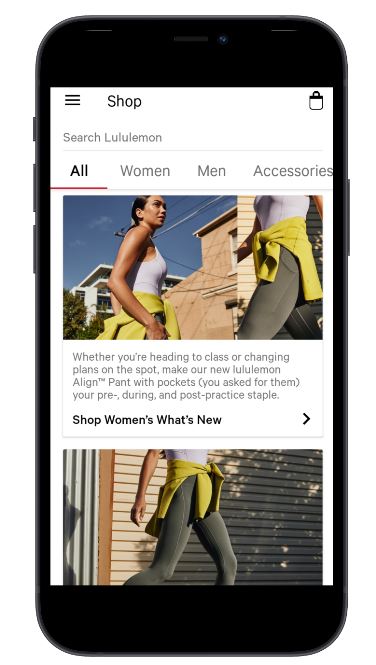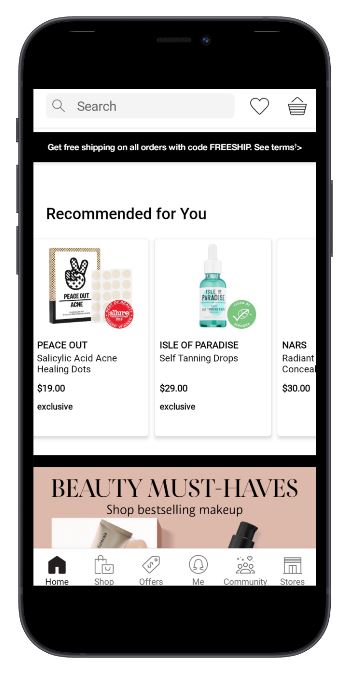What Are Some Good Examples of Mobile Commerce?

This blog post is based on my talk at AppCommerce Virtual Festival 2020 by Poq.
Mobile commerce is critical to today’s brands and retailers. More people shop via mobile devices, and customers are increasingly demanding more from the mobile shopping experience. Mobile-friendly websites do a decent job meeting these expectations but have their limitations.
Mobile apps can offer a better user experience and provide a level of functionality and fluidity unobtainable through a mobile website. In this post, we explore some of the required features for creating high-performing e-commerce apps. We also explore mobile e-commerce examples from the world’s most popular brands.
[toc-embed headline=”Next-Gen Mobile Commerce Features”]
Next-Gen Mobile Commerce Features
One-to-one personalization
Personalization is what allows brands to create a unique mobile experience. It’s one of the biggest app differentiators and organizations continue to implement new personalization features. This includes persistent login, the ability to choose the content, pre-populated local store, and more.
In-store companion
In-store features are no longer a nice add-on to have. Today, they are crucial to providing a connected shopping experience. Customers can surface information about a store’s selection ahead of time or use the app to learn more about an item they find in-store.
Contactless checkout and alternative fulfillment methods like buy online pickup in-store (BOPIS) help build consumer confidence in re-entering stores in a post-pandemic environment.
Clear and intuitive navigation
Screen space on mobile devices is limited. This means that brands and retailers need to have a clean navigation to allow customers to move between pages without disturbing the user experience.
Hook feature
Strong mobile apps have a hook feature that keeps users coming back for more. It’s an exciting feature, tailored to your unique offering and your customers. Recently, many companies have turned to augmented reality to differentiate their mobile app. This helps brands bring the store and products to the customer’s house, virtually.
[toc-embed headline=”World-Class Mobile Commerce Examples”]
World-Class Mobile Commerce Examples
Nike
Nike has been a leader in the e-commerce mobile space for several years with four apps (Nike App, Nike Run Club, SNKRS, and Nike Training Club) popular among customers. They have prioritized the mobile experience after realizing shoppers are more engaged while interacting via the mobile app when compared to a traditional website. Customers who buy through the app also spend much more on average.
The home screen is highly personalized to each individual user. The goal is to create a one-of-a-kind experience, making each customer feel like they’re shopping in their own Nike store. Products are recommended based on the user’s interests and items pre-select the appropriate size based on the customer’s order history.
Customers can use the app to scan a product’s barcode to get more information on the item. This tells them if the product is in stock at the store, and what colors and sizes are available.
Using the app, customers can also request to try on a pair of shoes. The app shows the confirmation of the request and the sales team brings the shoes to the customer.
Lululemon
Lululemon uses its mobile app as a means to streamline the in-person shopping experience. You can shop your local store through the app to find a product’s availability right from your phone. This way, you’ll know if your preferred size and color are in stock before going to the store.
The app is clean and easy to navigate. The home screen displays a product catalog filled with featured collections. A simple menu featuring the product categories enables users to navigate to the products of their choice.
The three-bar ‘burger’ icon in the left corner of the screen opens up a navigation bar that customers can use to manage their profile, track their orders, or find a physical store.
While in-store, you can scan the tags for a product to quickly learn more about the item. Users can store their personal and billing information, helping to speed up the checkout process.
Sephora
Sephora is a great example of an app with a hook feature that helps provide a unique mobile experience. The Sephora Virtual Artist uses augmented reality technology to allow users to try makeup on virtually. The app scans the user’s face to detect their facial features to know where to place the product. Customers can then see how a particular product looks on them.
With the in-store companion, you can quickly check to see if an item is in stock. It also allows you to book a reservation for services and events.
[toc-embed headline=”Conclusion”]
Conclusion
These are just a few of the companies providing truly great mobile experiences. If you would like to see more, check out:

EVP Revenue @ fabric. Previously @ Poq, ChannelAdvisor, and Xerox.


